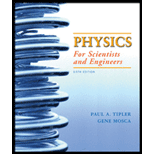
Concept explainers
(a)
To Show:
Path of the particle is circle of radius R.
(a)
Explanation of Solution
Given:
Mass of a particle
Position of a particle is given by
Radius of circle
Calculation:
To show that particle is moving in a circle take a dot product of
It is the equation of the circle with radius R and center at the origin. It is given, R
Conclusion:
It is shown that the path of this particle is the circle of radius R and center at the origin.
(b)
To Compute:
The velocity vectors.
To Show
:
(b)
Explanation of Solution
Given:
Mass of a particle
Position of a particle is given by
Radius of circle
Calculation:
Hence,
Conclusion:
It is shown that
(c)
To compute:
The acceleration vector
To Show:
The acceleration is directed towards the origin and has magnitude
(c)
Explanation of Solution
Given:
Calculation:
Hence,acceleration is directed towards the center.
Magnitude of acceleration is
But
Conclusion:
It is shown that the acceleration vector is directed towards the origin and has magnitude
(d)
To Find:
The magnitude and direction of net force acting on the particle.
(d)
Answer to Problem 130P
Magnitude of net force acting on the particle is
Explanation of Solution
Given:
Mass of a particle
Radius of circle
Formula Used:
Calculation:
The only force acting on the particle in a circular motion is the centripetal force. Hence the magnitude of the total force on the particle is
The direction of force is equal to the direction of centripetal acceleration i.e. towards the center, along the radius.
Conclusion:
The magnitude of the net force acting on the particle is
Want to see more full solutions like this?
Chapter 5 Solutions
EBK PHYSICS FOR SCIENTISTS AND ENGINEER
- A golf ball is struck with a velocity of 20 m/s at point A as shown below (Figure 4). (a) Determine the distance "d" and the time of flight from A to B; (b) Determine the magnitude and the direction of the speed at which the ball strikes the ground at B. 10° V₁ = 20m/s 35º Figure 4 d Barrow_forwardThe rectangular loop of wire shown in the figure (Figure 1) has a mass of 0.18 g per centimeter of length and is pivoted about side ab on a frictionless axis. The current in the wire is 8.5 A in the direction shown. Find the magnitude of the magnetic field parallel to the y-axis that will cause the loop to swing up until its plane makes an angle of 30.0 ∘ with the yz-plane. Find the direction of the magnetic field parallel to the y-axis that will cause the loop to swing up until its plane makes an angle of 30.0 ∘ with the yz-plane.arrow_forwardA particle with a charge of − 5.20 nC is moving in a uniform magnetic field of (B→=−( 1.22 T )k^. The magnetic force on the particle is measured to be (F→=−( 3.50×10−7 N )i^+( 7.60×10−7 N )j^. Calculate the y and z component of the velocity of the particle.arrow_forward
- Pls help ASAParrow_forwardPls help ASAParrow_forward9. When an electron moves into a uniform and perpendicular magnetic field, it will.. a. Accelerate parallel to the magnetic Field until it leaves b. Accelerate in a circular path c. Accelerate perpendicular to both the magnetic field and its original direction d. Repel back into the electric field 10. If a proton at rest is placed in a uniform magnetic field with no electric or gravitational field around, the proton will…….. a. Accelerate in the direction of the magnetic field b. Accelerate in a direction perpendicular to the magnetic field c. Move in a circular path d. Not acceleratearrow_forward
 Classical Dynamics of Particles and SystemsPhysicsISBN:9780534408961Author:Stephen T. Thornton, Jerry B. MarionPublisher:Cengage Learning
Classical Dynamics of Particles and SystemsPhysicsISBN:9780534408961Author:Stephen T. Thornton, Jerry B. MarionPublisher:Cengage Learning Principles of Physics: A Calculus-Based TextPhysicsISBN:9781133104261Author:Raymond A. Serway, John W. JewettPublisher:Cengage Learning
Principles of Physics: A Calculus-Based TextPhysicsISBN:9781133104261Author:Raymond A. Serway, John W. JewettPublisher:Cengage Learning Modern PhysicsPhysicsISBN:9781111794378Author:Raymond A. Serway, Clement J. Moses, Curt A. MoyerPublisher:Cengage Learning
Modern PhysicsPhysicsISBN:9781111794378Author:Raymond A. Serway, Clement J. Moses, Curt A. MoyerPublisher:Cengage Learning University Physics Volume 1PhysicsISBN:9781938168277Author:William Moebs, Samuel J. Ling, Jeff SannyPublisher:OpenStax - Rice University
University Physics Volume 1PhysicsISBN:9781938168277Author:William Moebs, Samuel J. Ling, Jeff SannyPublisher:OpenStax - Rice University Physics for Scientists and Engineers: Foundations...PhysicsISBN:9781133939146Author:Katz, Debora M.Publisher:Cengage Learning
Physics for Scientists and Engineers: Foundations...PhysicsISBN:9781133939146Author:Katz, Debora M.Publisher:Cengage Learning Glencoe Physics: Principles and Problems, Student...PhysicsISBN:9780078807213Author:Paul W. ZitzewitzPublisher:Glencoe/McGraw-Hill
Glencoe Physics: Principles and Problems, Student...PhysicsISBN:9780078807213Author:Paul W. ZitzewitzPublisher:Glencoe/McGraw-Hill





